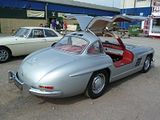

This was the 32nd Bristol Classic Car Show, and as such that makes it one of the longest running events in the UK. For much of that time, the Show took place at the Exhibition Centre which was right in the centre of the city, but when that complex was pulled down to enable redevelopment of the site, the organisers moved the event out to the Bath and West Showground which is just outside Shepton Mallet, 30 miles south of the city. Until 2010, the event typically took place in early February, and this made it notable in 2 ways: it tended to be among the first events of the year, and because the showground buildings are somewhat primitive, it was always necessary to wrap up well, as it could be a cold day out. The winter weather got the better of the organisers in 2010, though, and a late postponement saw the Show being rescheduled to the May Day Bank holiday weekend. More cars were able to be displayed and visitor numbers increased, leading to a plan in 2011 to hold the show at the later date once again. For whatever reason, these plans changed again, and the Show ended up being timed to coincide with National Drive It Day, a day when owners of classic and interesting vehicles are all exhorted to get them out and take to the roads. This proved to be an inspired move, as on the day I visited the show, as well as the 200 or so vehicles contained in the exhibition halls, there were more vehicles than you could take in, parked up outside. Doubtless the lovely spring weather helped. It also meant that the indoor displays were less chilly to behold, too. Those indoor displays comprised a mixture of marque or model owners clubs and those which serve a geographic area or interest group. Some of the cars were ones I recognised from previous years. but many were fresh, and there was plenty of interest. Indeed, I ended up spending the entire day at the event, revelling in the fact that many of the outdoor cars kept coming and going, so there was constantly something else new to see. Rather than separate out the indoor from outdoor, I have chosen to present this report by marque (more or less). With over 2500 classics in attendance, it was clearly not possible to capture everything, but I had a good go at recording some of the highlights. Enjoy! ALFA-ROMEO
No Alfas inside the show, but plenty outside. Some of them I recognised from their appearance at the Bristol Italian Auto Moto Festival the day before, but when they are as nice as this 1962 2600 Coupe, who can complain?
The Duetto Spider is also a very attractive car.
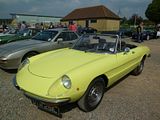 A late model Alfasud.
A late model Alfasud.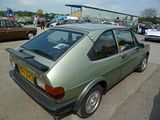 ALVIS
ALVISThree cars featured on the Alvis Owners Club stand, all of them from the pre war period, when the red triangle marque had a particularly strong reputation for producing high quality sporting vehicles.
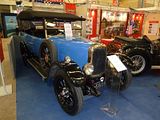
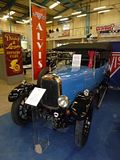
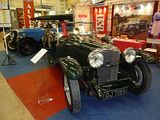 TC21/100 Grey Lady.
TC21/100 Grey Lady. ASTON MARTIN
ASTON MARTINThe DB4GT had a shorted wheelbase than the regular cars, and is accordingly even more valued than its sister car.
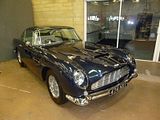 AUSTIN
AUSTINNo Seven’s inside the halls, but a couple had made the journey to be outside.
 Lone car on the “Counties” stand was this A40 Somerset. A mid sized car for middle England from 1952 – 1954.
Lone car on the “Counties” stand was this A40 Somerset. A mid sized car for middle England from 1952 – 1954.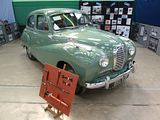
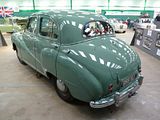 Smaller than this were the A30/A35 cars, and there were examples of the saloon, van and Countryman on show.
Smaller than this were the A30/A35 cars, and there were examples of the saloon, van and Countryman on show.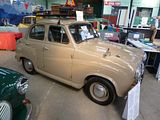
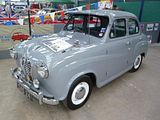
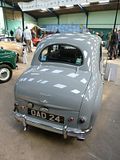
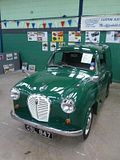
 By the mid 1950s, the offering was called Cambridge and was denoted by A50, or the later A55. 6 cylinder cars were the Westminster, and came in A90, A95 and top of the line A105 Vanden Plas versions.
By the mid 1950s, the offering was called Cambridge and was denoted by A50, or the later A55. 6 cylinder cars were the Westminster, and came in A90, A95 and top of the line A105 Vanden Plas versions.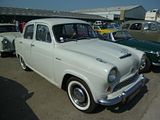
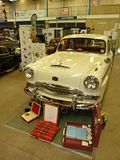
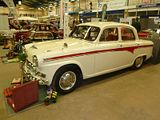
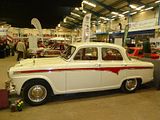 These cars were succeeded by the Farina designed range, and this is an early car with the prominent tail fins and period hues.
These cars were succeeded by the Farina designed range, and this is an early car with the prominent tail fins and period hues.
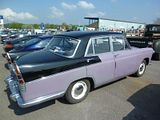 This 1983 Metro Vanden Plas had covered a mere 32,000 miles from new, and was absolutely pristine. Featuring the optional automatic transmission, it had had a long rest after its initial purchase, but its current owners are using it, albeit sparingly.
This 1983 Metro Vanden Plas had covered a mere 32,000 miles from new, and was absolutely pristine. Featuring the optional automatic transmission, it had had a long rest after its initial purchase, but its current owners are using it, albeit sparingly.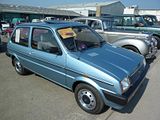 AUSTIN-HEALEY
AUSTIN-HEALEYAnother staple of the classic scene is the Big Healey, and there were a few here.
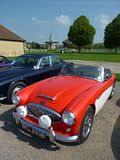
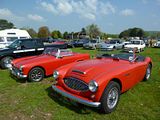 CHEVROLET
CHEVROLETA pair of Chevrolets from the 1940s: A StyleMaster van and FleetMaster sedan. Splendid!
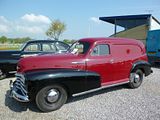
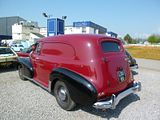
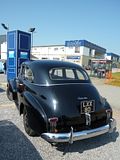
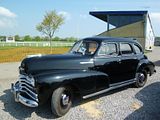 CITROEN
CITROENA Dyane. the interior was non standard, but these cars are rare now, having lost out in the popularity stakes to the closely related 2CV
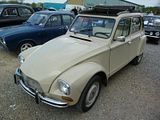 There were a couple of DS, showing the later models with the swivelling headlights and an earlier Safari car.
There were a couple of DS, showing the later models with the swivelling headlights and an earlier Safari car.
 DAF
DAFDefinitely one of the rarer cars of the day, this 55 Marathon Coupe evoked lots of comments from those who remembered them from new about elastic bands.
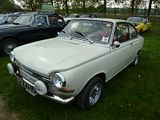 There was a close relative of this car, as you will see later in the report.DAIMLER
There was a close relative of this car, as you will see later in the report.DAIMLER
The V8250 was based on the popular Mark 2 Jaguar, but with its own small capacity V8 engine.
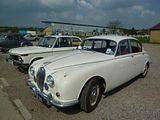 Before the badge engineering practice started, Daimler produced a range of their own cars, many of which had coachbuilt bodies fitted to them. This is one such, dating from around 1950.
Before the badge engineering practice started, Daimler produced a range of their own cars, many of which had coachbuilt bodies fitted to them. This is one such, dating from around 1950. The Majestic was also a Daimler with no equivalent Jaguar model.
The Majestic was also a Daimler with no equivalent Jaguar model.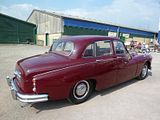 FIAT
FIATThe one Nuova 500 inside the halls was so comprehensively covered in “stuff” that you could barely see the car. Luckily., there was another one outside, parked up next to the latest TwinAir model.
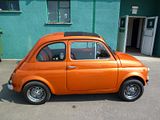
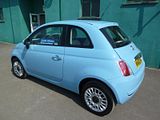
 In the UK, the 600 is far less common than its smaller brother, but here is one.
In the UK, the 600 is far less common than its smaller brother, but here is one.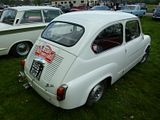
 There were not many Fiats at the event, but this late model X1/9 almost made up for that fact.
There were not many Fiats at the event, but this late model X1/9 almost made up for that fact.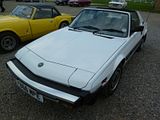 FORD
FORDA large stand contained a wide variety of V8 cars from the 1930s, which was also blessed with a rather smaller UK model Anglia, which had been “updated”.



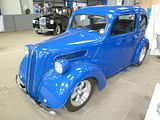
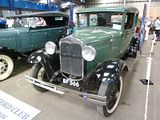 From the early 1950s, the Prefect and Anglia were the smaller cars in the Ford UK range, and there was a 1953 Prefect on show inside. Outside, I came across an Australian Ute version of this vehicle, not something I had ever seen before.
From the early 1950s, the Prefect and Anglia were the smaller cars in the Ford UK range, and there was a 1953 Prefect on show inside. Outside, I came across an Australian Ute version of this vehicle, not something I had ever seen before. 

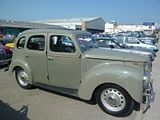
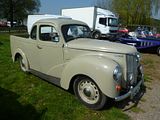 The 1956 Mark 2 Zodiac
The 1956 Mark 2 Zodiac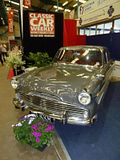 A real American, this is an late 1950s Thunderbird. It burbled its way out of the car park during the early afternoon.
A real American, this is an late 1950s Thunderbird. It burbled its way out of the car park during the early afternoon.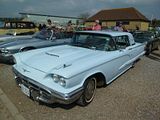 Not many Fords have failed to sell well, but this is one such car, the Consul Classic, which had a short production life of just 3 years before the Cortina and Corsair took over.
Not many Fords have failed to sell well, but this is one such car, the Consul Classic, which had a short production life of just 3 years before the Cortina and Corsair took over. Survival rates of the early Ford Mustang are good, and although most of the cars are to be found in its native land, there are a good few in the UK as well, such as this neatly presented hardtop car.
Survival rates of the early Ford Mustang are good, and although most of the cars are to be found in its native land, there are a good few in the UK as well, such as this neatly presented hardtop car.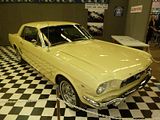 The Mark 1 Escort has a sizeable following, with more evidence of the high end sporting cars, even though some of them may have started out as 1100 cars that have been upgraded. There were examples of the RS1600, RS2000 and the Mexico in evidence.
The Mark 1 Escort has a sizeable following, with more evidence of the high end sporting cars, even though some of them may have started out as 1100 cars that have been upgraded. There were examples of the RS1600, RS2000 and the Mexico in evidence. 
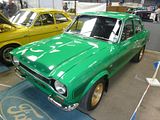
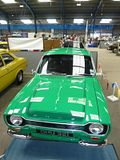
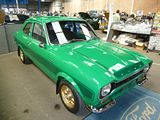
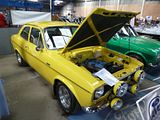
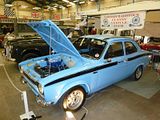
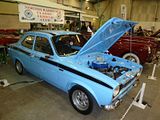 The Capri Owners Club stand featured two cars, one of which was a replica of the South African Basil Green’s team Gunston Racing car. Some others were parked up outside.
The Capri Owners Club stand featured two cars, one of which was a replica of the South African Basil Green’s team Gunston Racing car. Some others were parked up outside.
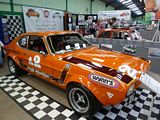
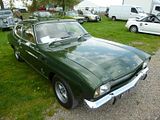 There were plenty of Cortinas at the show. As this was a best selling car for most of its 20 year production, that is only right and proper. Mark 1s and 2s were on a stand where the centre piece was a recently created “limousine” version of the Mark 1.
There were plenty of Cortinas at the show. As this was a best selling car for most of its 20 year production, that is only right and proper. Mark 1s and 2s were on a stand where the centre piece was a recently created “limousine” version of the Mark 1.
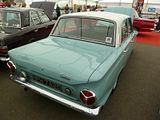


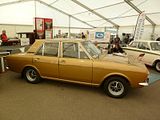 There were a couple of Lotus Cortina models, too.
There were a couple of Lotus Cortina models, too.
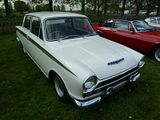 These Mark 3 cars were actually not standard. The yellow one had received a 3 litre V6 engine transplant, and the green one was one of the Uren Savage conversions.
These Mark 3 cars were actually not standard. The yellow one had received a 3 litre V6 engine transplant, and the green one was one of the Uren Savage conversions.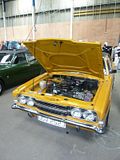
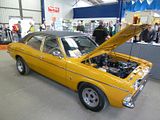

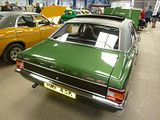 A Mark 3 2000E was to be found outside, though.
A Mark 3 2000E was to be found outside, though.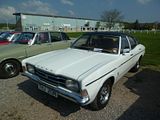

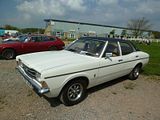
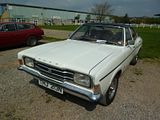 Parked up outside were a number of the Mark IV cars, and inside the halls was a stunning example of the Mark V car, which looked absolutely pristine.
Parked up outside were a number of the Mark IV cars, and inside the halls was a stunning example of the Mark V car, which looked absolutely pristine.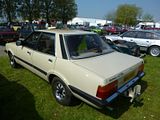
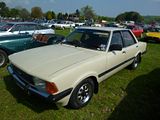
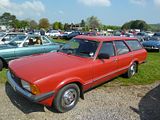

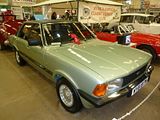


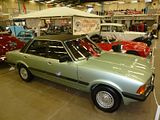
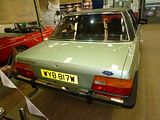 Not one, but two of the facelifted Mark I Fiesta were on display. These are rare cars now. Basic as hell, too, unless you can find a Ghia.
Not one, but two of the facelifted Mark I Fiesta were on display. These are rare cars now. Basic as hell, too, unless you can find a Ghia.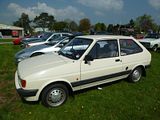
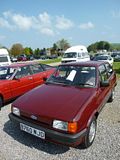 Unspoilt Sierra Cosworths are rare, but they do exist. This is one such.
Unspoilt Sierra Cosworths are rare, but they do exist. This is one such.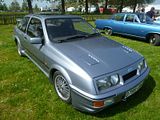 A top of the range Granada Ghia X, with a few additions that doubtless were not part of the original spec. This one seemed to evoke lots of memories for many show attendees.
A top of the range Granada Ghia X, with a few additions that doubtless were not part of the original spec. This one seemed to evoke lots of memories for many show attendees.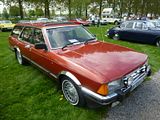 The Crown Vic is a common sight in the US, still, but not over here. Bet the owner winces every time he has to fill the tank!
The Crown Vic is a common sight in the US, still, but not over here. Bet the owner winces every time he has to fill the tank!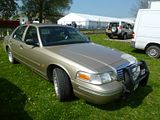 GILBERN
GILBERNThree Invader models were on the stand, of which the estate was perhaps the rarest of the trio.
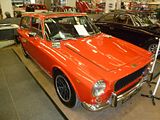
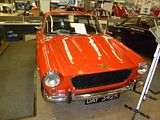

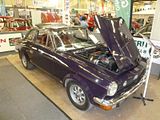 GREGOIRE
GREGOIRE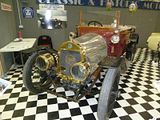 HEARSES
HEARSESTwo of these vehicles were on show inside the exhibition. One was based on a Toyota Cressida, and is definitely unusual, the other with a Mark IV Zephyr based was far more commonplace in the 1970s.
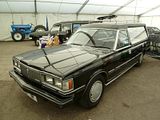
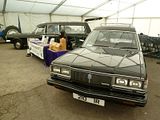
 HILLMAN
HILLMANMinx was a long running name for Hillman, and was the core of their range from its launch in the early 1930s until it was phased out in 1970. There were three cars with the word in their title on the Hillman Owners Club stand. There was an early car, an example of the all new “Audax” based cars that first appeared in 1956 and a Super Minx estate car from the mid 1960s.

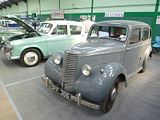

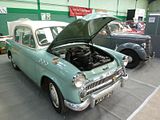
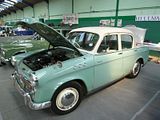
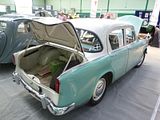
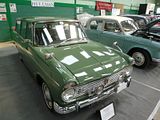
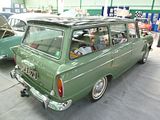
 There was another Super Minx parked up outside. This was an early car with the wrap around rear window.
There was another Super Minx parked up outside. This was an early car with the wrap around rear window. Avenger was Hillman’s answer to the popular Cortina and Viva, though it never achieved quite the same sales success. There were a couple of neat cars inside and some less immaculate ones outside.
Avenger was Hillman’s answer to the popular Cortina and Viva, though it never achieved quite the same sales success. There were a couple of neat cars inside and some less immaculate ones outside.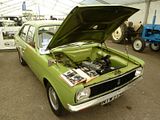
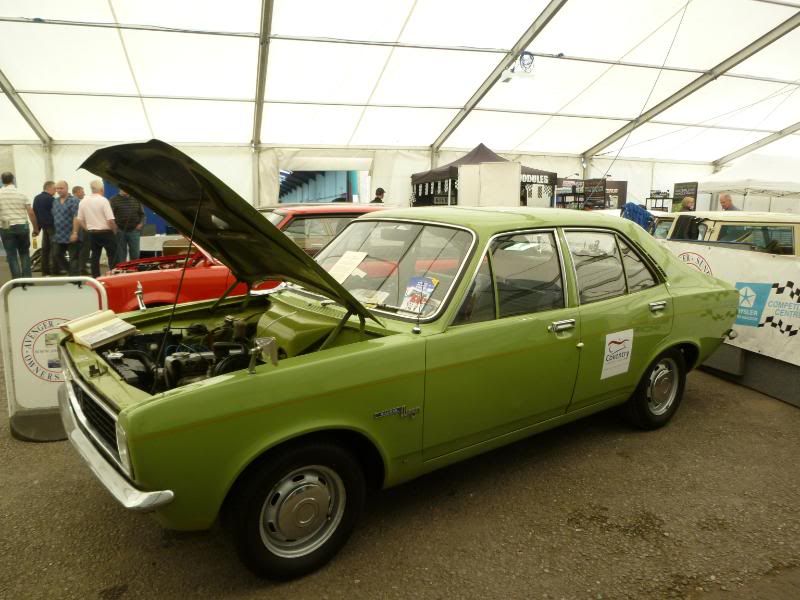

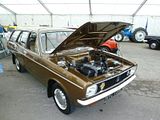
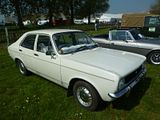 Based on this was the Sunbeam hatch, although it was badged Chrysler and Talbot during its short production life. This is the warm Ti version.
Based on this was the Sunbeam hatch, although it was badged Chrysler and Talbot during its short production life. This is the warm Ti version.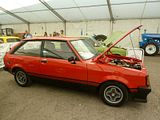
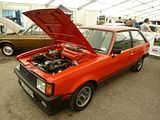
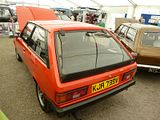
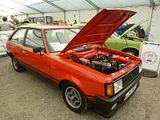 HRG
HRGThese days, an almost forgotten marque, HRG made small, light and affordable sports cars in the 1930s.

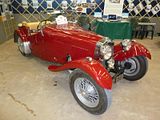 HUMBER
HUMBERA luxury brand for those whose pockets could not quite run to Jaguar or Rolls Royce, the Humber saw service both as an owner driven car, a chauffeured vehicle and even the base for a hearse. These examples show some of the different models from the 1930s to the 1950s.
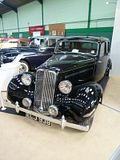
 Elsewhere, this Hawk was one of the last of the classic Humber cars before the badge was used simply to denote the luxury version of the far smaller Hillman Hunter.
Elsewhere, this Hawk was one of the last of the classic Humber cars before the badge was used simply to denote the luxury version of the far smaller Hillman Hunter.
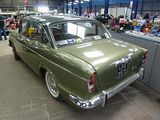 IMP
IMPThe Imp Owners usually have one of the more imaginative stands, and this year was no exception. Just two cars were on show, and they were both Convertibles. Before you delve too far into he memory bank, no these were not factory offerings, but more recent conversions, and yes, I thought they did actually look quite good. Shame that Rootes did not offer these, as they could have sold well as a cheaper alternative to the (lovely) Fiat 850 Spider of the same era.
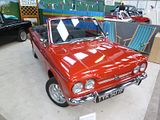
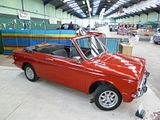


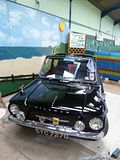
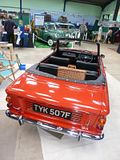
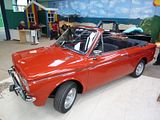
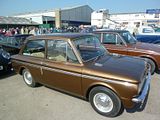 JAGUAR
JAGUARAlthough badged “Austin Swallow”, this car is an early example of the sort of model produced by Sir William Lyons before his more overtly sporting (and costly) cars arrived in the 1930s.
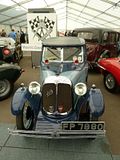 2011 marks the 50th anniversary of the “E” Type., and so these popular sports cars are bound to feature at events such as this, even more than usual. There was only one such car inside, but plenty were out and about, too.
2011 marks the 50th anniversary of the “E” Type., and so these popular sports cars are bound to feature at events such as this, even more than usual. There was only one such car inside, but plenty were out and about, too.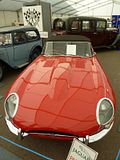
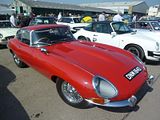 There were plenty of the much loved Mark 2 cars parked up outside.
There were plenty of the much loved Mark 2 cars parked up outside.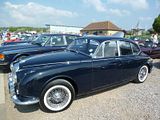
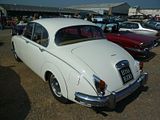 There were also some other saloons, ranging from the bulbous Mark X to the 420 and the later XJ6/12 cars.
There were also some other saloons, ranging from the bulbous Mark X to the 420 and the later XJ6/12 cars.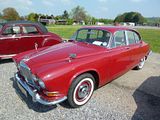
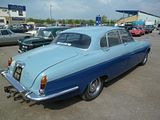 The XJS is now a classic. The early cars are rare, but this is one such, and it was joined by Jaguar’s first attempt at an open version, which was available from 1983 and until the full convertible arrived in 1988.
The XJS is now a classic. The early cars are rare, but this is one such, and it was joined by Jaguar’s first attempt at an open version, which was available from 1983 and until the full convertible arrived in 1988.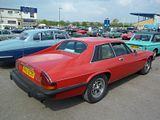
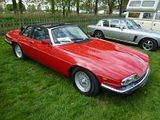 JENSEN
JENSENFour cars featured on the Jensen Owners Club stand. Most unusual was this 541 Convertible. Only two such cars are believed to have been built, and this one was only recently discovered after a 40 year disappearing trick. It is believe that this car was the Earls Court Show car. It will be fully restored.
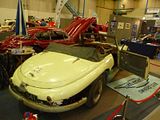
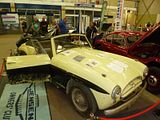 More familiar is the Interceptor, and the car on the stand was augmented by several that were parked up outside.
More familiar is the Interceptor, and the car on the stand was augmented by several that were parked up outside.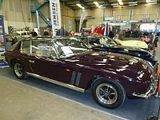 Outside, I came across a couple of CV8s.
Outside, I came across a couple of CV8s.
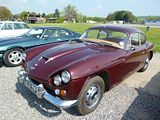 The Jensen GT seems to have eluded my camera. but the open top version, the Jensen Healey did not.
The Jensen GT seems to have eluded my camera. but the open top version, the Jensen Healey did not.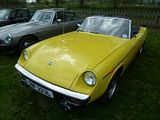
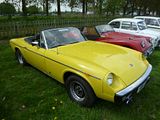 LAGONDA
LAGONDAAnother of the more unusual cars of the day, was this drophead convertible dating from around 1950.
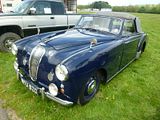 “LANDCRAB”
“LANDCRAB”Another Owners Club that always puts lots of effort into their show stand, and this year they won the prize for being the best. The 2011 theme was around a National (a brand that has long since disappeared) filling station, with 2 of the ADO17 “Landcrab” cars ready to be refuelled.
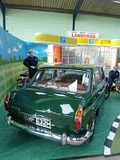
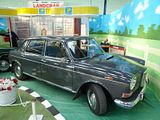 LAND-ROVER
LAND-ROVEROccupying the same stand position as in previous years, the Series One Land Rover Club had some well preserved examples of the Landie on show.

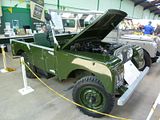 MARCOS
MARCOSThere were two separate stands for this British sports car. One featured a duo of recent cars, the ill-fated TSO model was joined by an LM500
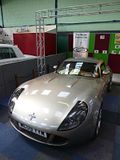
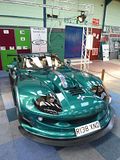
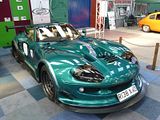 On the other Marcos Owners Club stand, there were a couple of earlier models.
On the other Marcos Owners Club stand, there were a couple of earlier models.
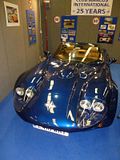 MERCEDES-BENZ
MERCEDES-BENZUnsurprisingly, one of the most popular cars at the event was this 300SL GullWing, which was parked up outside the auction halls.
 I really like the “Pagoda” W107 SL cars. So does the market and prices have rocketed in recent years.
I really like the “Pagoda” W107 SL cars. So does the market and prices have rocketed in recent years.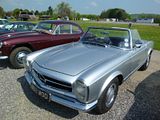 The W123 is now a “youngtimer” classic, as the Germans call them. This coupe looked good. It was complemented by its replacement a W124 model.
The W123 is now a “youngtimer” classic, as the Germans call them. This coupe looked good. It was complemented by its replacement a W124 model.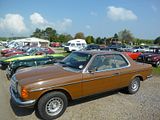
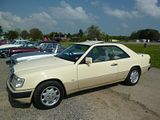 Dating years it elder was this “Fintail” 220 model. These cars were fearsomely expensive in the UK when new, so not many were sold at the time. The left hand drive of this one suggests it came here more recently.
Dating years it elder was this “Fintail” 220 model. These cars were fearsomely expensive in the UK when new, so not many were sold at the time. The left hand drive of this one suggests it came here more recently.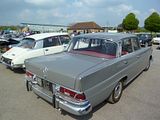 MESSERSCHMIT
MESSERSCHMITThe diminutive Tiger.
 MG
MGCentrepiece of one of the exhibition halls was a display of early MGs. Highlight for many people, and indeed a Show award winner was this, a 1925 Bullnose Supersport Salonette. Just 6 of these cars were made, and this is believed to be the only survivor. Hard to imagine now, but the 13.9HP generated by the 1802cc engine, coupled with a 3 speed gearbox made this a sporting saloon!
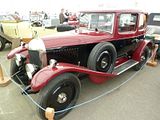
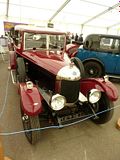
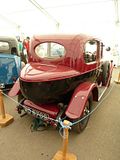 This 1931 18/80 Mark II De Luxe is one of only 50 cars that were made, and is believed to the sole survivor of the specific model. Only 24 Mark IIs survive in total.
This 1931 18/80 Mark II De Luxe is one of only 50 cars that were made, and is believed to the sole survivor of the specific model. Only 24 Mark IIs survive in total.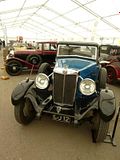

 This 1928 14/40 Mark IV Sports 2 seater is also a rare beast. One of only 135 cars that were built, this is also believed to be the sole survivor.
This 1928 14/40 Mark IV Sports 2 seater is also a rare beast. One of only 135 cars that were built, this is also believed to be the sole survivor.
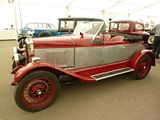 This is a 1930 18/80 Mark II
This is a 1930 18/80 Mark II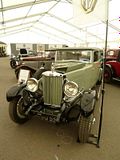
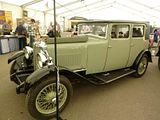 A 1927 14/28 Four Seat Tourer. 21 of these cars remain, from an initial population of 491.
A 1927 14/28 Four Seat Tourer. 21 of these cars remain, from an initial population of 491. This 1930 18/80 Mark III Tigress was a genuine 100 mph car. For the brave!
This 1930 18/80 Mark III Tigress was a genuine 100 mph car. For the brave!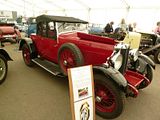
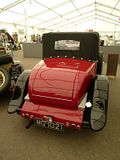 Also dating from 1930, this 18/80 Sports Six Mark II 2 seater saw early service as the test car for “the Motor”, though its history after that time seems to be largely unknown.
Also dating from 1930, this 18/80 Sports Six Mark II 2 seater saw early service as the test car for “the Motor”, though its history after that time seems to be largely unknown.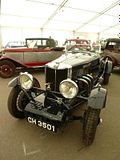 Another stand was populated with 4 x 1931 C-type Midgets, in a diaroma type setting to remind everyone that these little sports car were popular in motor racing circles.
Another stand was populated with 4 x 1931 C-type Midgets, in a diaroma type setting to remind everyone that these little sports car were popular in motor racing circles. 
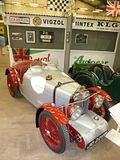
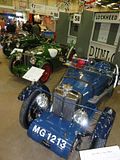 b
b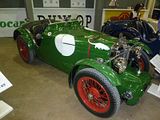
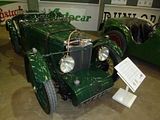
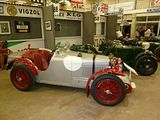 There were plenty of the better known post war sports cars, too, such as these MGA and MGB models, as well as numerous Midgets.
There were plenty of the better known post war sports cars, too, such as these MGA and MGB models, as well as numerous Midgets.
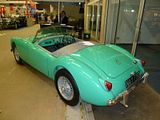
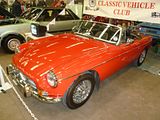
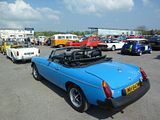
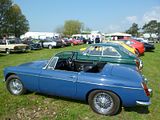
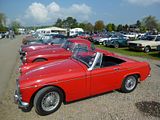
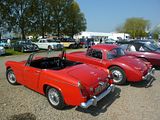
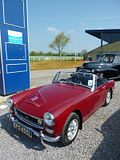 The ADO16 range were Britain’s best selling cars for many years and the MG version was the sporting offering in that family. This is a late model Mark II 1300 saloon.
The ADO16 range were Britain’s best selling cars for many years and the MG version was the sporting offering in that family. This is a late model Mark II 1300 saloon.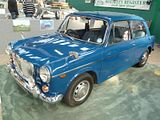 MINI
MINIThe Mini Owners Club had a stand which featured a mix of cars from a regular saloon to an example of both the now rare van and pickup.

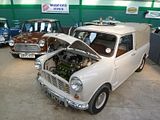
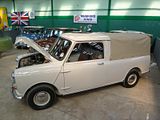

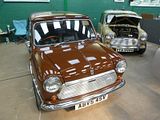 Several more classic Minis were to be found outside.
Several more classic Minis were to be found outside. MORGAN
MORGANFour cars made up this stand, showing the progression from the early 3 wheeled cars, through the Plus 4 of the 1930s to the body style still in production today for which Morgan is perhaps best known.



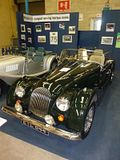

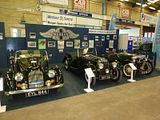
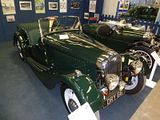 There were more Morgans outside.
There were more Morgans outside. MORRIS
MORRISEarliest Morris was this, a 1925 “Bullnose” Oxford.
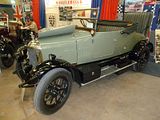 This is a 1929 Minor van, which has been recently restored.
This is a 1929 Minor van, which has been recently restored. From the pre war period were these three cars, an Eight, and a Ten
From the pre war period were these three cars, an Eight, and a Ten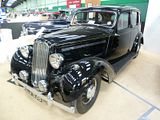
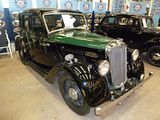

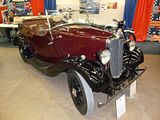 The Morris Minor is a staple at all British classic car events, and there were plenty of them at Shepton Mallet. Two cars featured on the Owners club stand.
The Morris Minor is a staple at all British classic car events, and there were plenty of them at Shepton Mallet. Two cars featured on the Owners club stand.
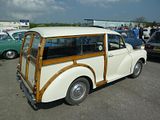
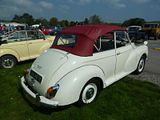
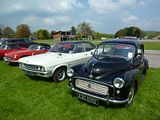 It is not only cars that were praised or rated as “good” that attract attention and love in later life. The Morris Marina definitely comes in this category, as this was not really the best in class even when new, however, these days it does have something of a cult following. Two cars were in the main exhibition: the coupe was the facelifted Series 2 car, with the “O” series engine fitted, and was to be found on the Practical Classics stand, whilst the oh so very period “Sandglow” car, also a Series 2, had featured recently in that magazine in a feature marking the 40th anniversary of the launch of the car.
It is not only cars that were praised or rated as “good” that attract attention and love in later life. The Morris Marina definitely comes in this category, as this was not really the best in class even when new, however, these days it does have something of a cult following. Two cars were in the main exhibition: the coupe was the facelifted Series 2 car, with the “O” series engine fitted, and was to be found on the Practical Classics stand, whilst the oh so very period “Sandglow” car, also a Series 2, had featured recently in that magazine in a feature marking the 40th anniversary of the launch of the car.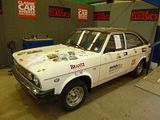

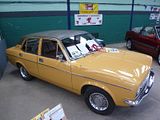
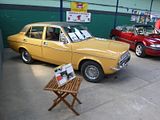 OPEL
OPELAs far as I recall, this Monza was the only Opel at the event.
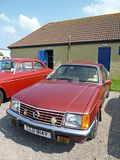 PLYMOUTH
PLYMOUTHEven by 1941, when this car was made, American cars were noticeably larger than their European competitors.
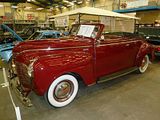
 Although this 1963 Valiant was supposed to be a “compact”, it is also not exactly small to European eyes.
Although this 1963 Valiant was supposed to be a “compact”, it is also not exactly small to European eyes.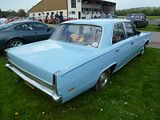 PORSCHE
PORSCHEOnly a few of Stuttgart’s finest, but three cars managed to line up alongside each other for some marque solidarity.
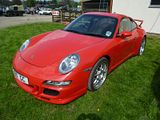
 RELIANT
RELIANTThe Scimitar GTE has always been popular, and thanks to its glass fibre body, has had fewer rust issues than many of its contemporaries. Several turned up here.
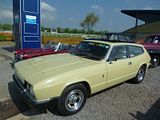
 The Sabre was the precursor to the Scimitar models and is far less often encountered.
The Sabre was the precursor to the Scimitar models and is far less often encountered.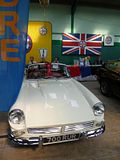
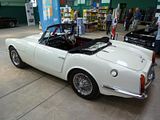 RILEY
RILEYRiley’s offering for most of the 1950s was the RM series, offered in saloon and convertible versions, with 1.5 and 2.5 litre engines. These sports saloons were popular then and still are now. Example of both body styles were on show.
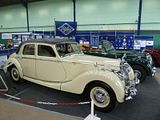
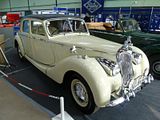

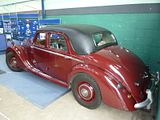
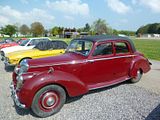
 The OnePointFive was originally intended to form a replacement for the venerable Morris Minor, but Riley and Wolseley versions were the only models which ever made production, and the Minor went on to outlast this design by some years.
The OnePointFive was originally intended to form a replacement for the venerable Morris Minor, but Riley and Wolseley versions were the only models which ever made production, and the Minor went on to outlast this design by some years.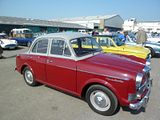
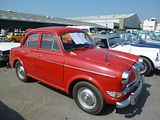
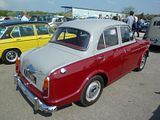
 Smaller brother to this car was the Mini-based Elf, which was launched 50 years ago.
Smaller brother to this car was the Mini-based Elf, which was launched 50 years ago. 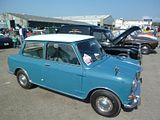
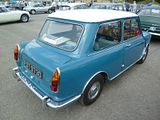 ROCHDALE
ROCHDALEThe Olympic model is relatively well known, and can often be seen at events such as this one. Less common, indeed a car I am not sure I have ever seen before, is the GT. The show car here was found in a rather dilapidated state, but has been restored to a splendid condition by an enthusiastic and dedicated owner.
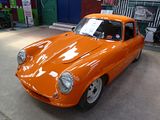

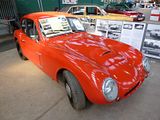 ROLLS ROYCE
ROLLS ROYCEA particularly elegant 20/25 model.
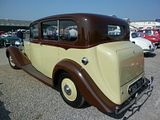
 ROVER
ROVERThe P3 75 model.
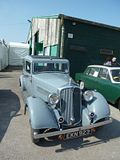 The P5 saw active service for Government and officials that lasted many years after production ceased in 1973, and was also a favourite of Her Majesty. Two of these cars were on the P5 Owners Club stand, one example of each of the 3 litre and the later 3.5 litre, the latter of which had been used as a diplomatic car in its early life.
The P5 saw active service for Government and officials that lasted many years after production ceased in 1973, and was also a favourite of Her Majesty. Two of these cars were on the P5 Owners Club stand, one example of each of the 3 litre and the later 3.5 litre, the latter of which had been used as a diplomatic car in its early life.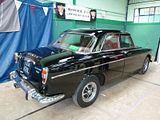
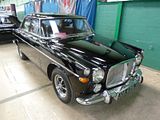
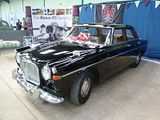
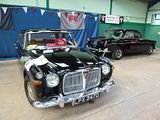
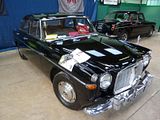
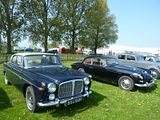 There was another one outside, along with several of the smaller P6 cars. The Avocado finish on this one is so very 1970s!
There was another one outside, along with several of the smaller P6 cars. The Avocado finish on this one is so very 1970s!
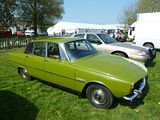 Hard to believe, but the first of the R8 cars appeared over 21 years ago. They are a still diminishing sight on our roads, as rust and wear and tear take their toll, but some have been preserved, and there were a regular 216 GTi 3 door, a Cabrio and the “Tomcat” Coupe on show as evidence.
Hard to believe, but the first of the R8 cars appeared over 21 years ago. They are a still diminishing sight on our roads, as rust and wear and tear take their toll, but some have been preserved, and there were a regular 216 GTi 3 door, a Cabrio and the “Tomcat” Coupe on show as evidence.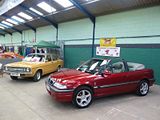
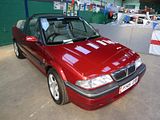
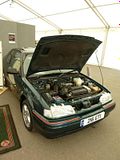
 The SD1 was a very futuristic design when launched, and the object of many a school boy’s adulation (mine included!). The face lifted cars are the ones you see more often, these days, but there was an early car at the show as well as some of the later ones.
The SD1 was a very futuristic design when launched, and the object of many a school boy’s adulation (mine included!). The face lifted cars are the ones you see more often, these days, but there was an early car at the show as well as some of the later ones.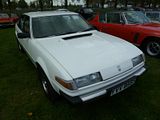

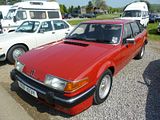


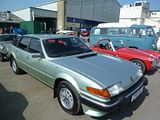 SAAB
SAAB
Three cars on the SAAB Owners Club stand, all from the time before GM had acquired the brand. The two 99s, one of which was the iconic turbo, were augmented by the “bull nosed” 96.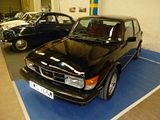
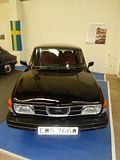
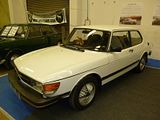
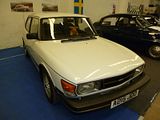


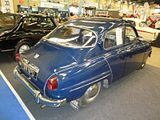
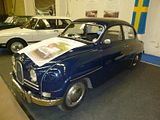 SINGER
SINGERTo mark the 60th anniversary of the Singer Owners Club, a special display of Singer cars was to be found outside the main halls. This encompassed the wide variety of types of car that this Coventry marque offered, starting with the 1929 model Junior, which was conceived as a response to the cheap small cars from Austin and Morris.


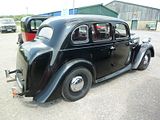 During the 1930s, and continuing post war, Singer made a series of small sports cars, based on their 9 model, using the 9 and Le Mans names for them. A further example was on display inside.
During the 1930s, and continuing post war, Singer made a series of small sports cars, based on their 9 model, using the 9 and Le Mans names for them. A further example was on display inside.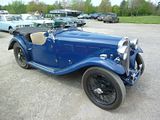
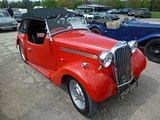


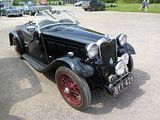

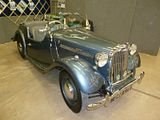
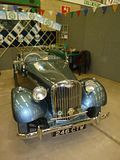 The last “real” Singer, before the Rootes Group acquisition was the short lived SM1500 like this one.
The last “real” Singer, before the Rootes Group acquisition was the short lived SM1500 like this one.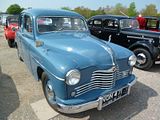
 In 1956, Singer launched the Gazelle, which was the luxury version of the more prosaic Hillman Minx. The Gazelle was offered in saloon, estate and convertible versions, and examples of the first and last of these were on show.
In 1956, Singer launched the Gazelle, which was the luxury version of the more prosaic Hillman Minx. The Gazelle was offered in saloon, estate and convertible versions, and examples of the first and last of these were on show.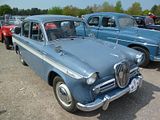
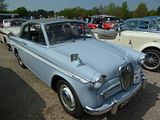
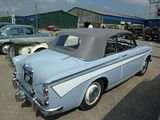
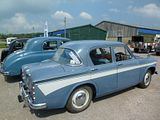
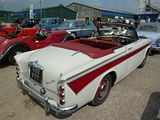 When Hillman came up with a larger stable-mate, in 1961, Singer dusted off the Vogue name for their version of the Super-Minx, and this is the very practical estate version of that car.
When Hillman came up with a larger stable-mate, in 1961, Singer dusted off the Vogue name for their version of the Super-Minx, and this is the very practical estate version of that car.
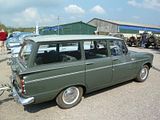 STANDARD
STANDARDTwo cars on the Standard Motor Club stand, from the 1920s and 1930s.
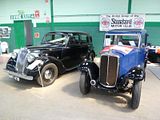
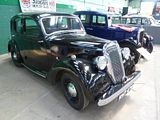 The Phase 3 Vanguard.
The Phase 3 Vanguard.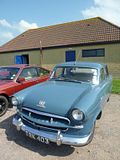
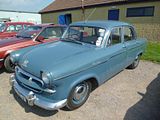 SUNBEAM
SUNBEAMThe Sunbeam Talbot 90 was a moderately priced sports saloon from the early to mid 1950s that was popular then and now in motor sports events.
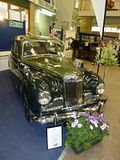 The Alpine Owners had a stand which comprised a mixture of the two seater sports car that was produced from 1959 to 1967 and also a couple of nicely presented “Arrow” based Coupes. The turquoise car was a deserved prize winner, and looked immaculate. Knowing first hand just what the propensity of the Arrow cars was for rusting, getting and keeping a car like this is no mean achievement.
The Alpine Owners had a stand which comprised a mixture of the two seater sports car that was produced from 1959 to 1967 and also a couple of nicely presented “Arrow” based Coupes. The turquoise car was a deserved prize winner, and looked immaculate. Knowing first hand just what the propensity of the Arrow cars was for rusting, getting and keeping a car like this is no mean achievement.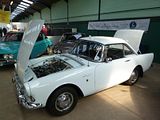
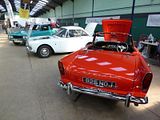
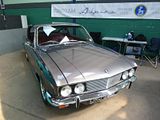

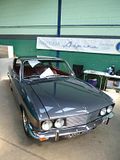

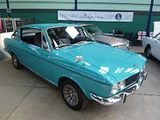
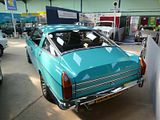
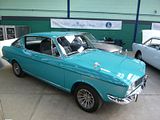
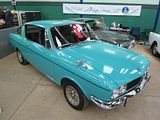 Outside, I came across more than one of the desirable Tiger cars. The more of these I see, the more I like them. Subtle looks, but with a real punch from their big V8 Ford engines under the bonnet.
Outside, I came across more than one of the desirable Tiger cars. The more of these I see, the more I like them. Subtle looks, but with a real punch from their big V8 Ford engines under the bonnet. 
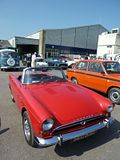
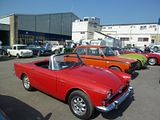
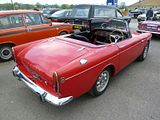
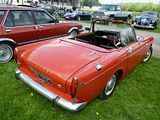
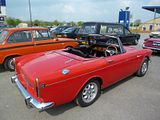 A small number of these Harrington cars were made, creating an instant Coupe GT out of the standard roadster model. Very rare.
A small number of these Harrington cars were made, creating an instant Coupe GT out of the standard roadster model. Very rare.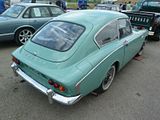 There were also a couple of Rapiers, showing how this car evolved from being an “Audax” based Coupe to an “Arrow” based one.
There were also a couple of Rapiers, showing how this car evolved from being an “Audax” based Coupe to an “Arrow” based one.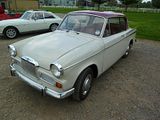
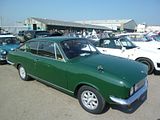 TRACTORS
TRACTORSPerhaps appropriate for the venue, given its agricultural roots, there were 4 vintage tractors parked up in a line at one end of one of the halls. three Ford(son) and a David Brown showed how these ubiquitous farm workhorses started to get noticeably larger even in the 1960s.

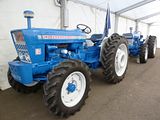
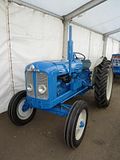
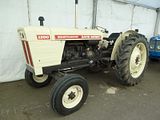 TRIUMPH
TRIUMPHThis Renown dates from 1949, and was the larger of the 2 saloon cars offered by Triumph in the post war period. It never quite hit the mark in terms of combining luxury and sporting prowess in the same way as Riley did, though.
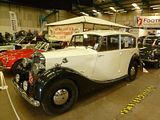
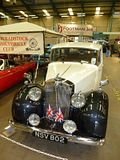
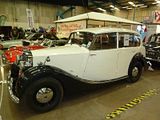
 Wind the clock on a couple of model generations and you end up at the 2000/2500 range, which were excellent cars in their day. There were examples of both saloon and estate cars of this type.
Wind the clock on a couple of model generations and you end up at the 2000/2500 range, which were excellent cars in their day. There were examples of both saloon and estate cars of this type.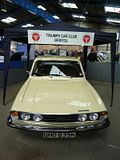
 Just one car was on the Stag Owners Club stand, which had the vehicle rotating gently on a turntable. There were several more Stags on show outside.
Just one car was on the Stag Owners Club stand, which had the vehicle rotating gently on a turntable. There were several more Stags on show outside.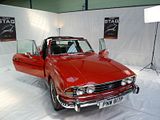
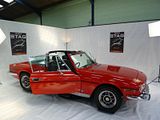

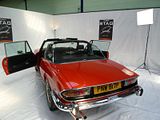
 TRs are another popular car among the classic owning fraternity and there were a few of these, mostly 4s and 5s on show.
TRs are another popular car among the classic owning fraternity and there were a few of these, mostly 4s and 5s on show.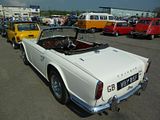
 Plenty of the Vitesse and Herald cars were to be found outside.
Plenty of the Vitesse and Herald cars were to be found outside.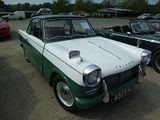


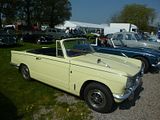
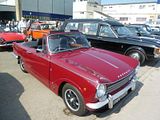
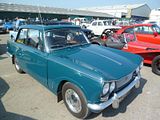 Successor to this car was the front wheel drive 1300, now far rarer than its older sibling.
Successor to this car was the front wheel drive 1300, now far rarer than its older sibling.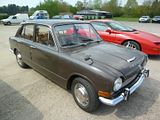
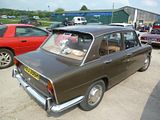 The Dolomite Sprint is another of those cars that I really liked when I was growing up, and the enthusiasm has not really gone away. Mimosa is the “best” colour for the car, too..
The Dolomite Sprint is another of those cars that I really liked when I was growing up, and the enthusiasm has not really gone away. Mimosa is the “best” colour for the car, too..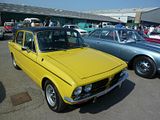
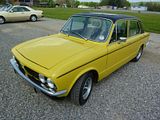 VAUXHALL
VAUXHALLAn early 1950s Wyvern. This was a large family car of its period, and in more luxurious Cresta format was quite an aspirational vehicle for its day.
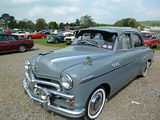 Wyvern was replaced by Victor, which went through 5 model generations. This ultimately spawned the sporting VX4/90 and the plush and rapid Ventora which combined Vauxhall’s largest engine with a medium sized body. Two of the FD generation of these cars were on show. One of them looked rather better than the other!
Wyvern was replaced by Victor, which went through 5 model generations. This ultimately spawned the sporting VX4/90 and the plush and rapid Ventora which combined Vauxhall’s largest engine with a medium sized body. Two of the FD generation of these cars were on show. One of them looked rather better than the other!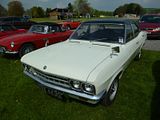
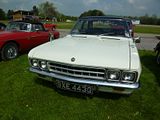
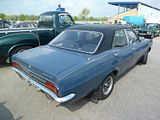 The Viva HC, once a common sight, but now very rare.
The Viva HC, once a common sight, but now very rare.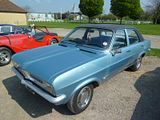 Far rarer, though, were these two: a Cavalier Centaur, and the Royale Coupe. a badge engineered version of the better known Opel Monza.
Far rarer, though, were these two: a Cavalier Centaur, and the Royale Coupe. a badge engineered version of the better known Opel Monza.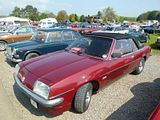
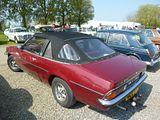
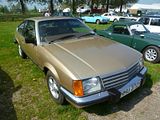
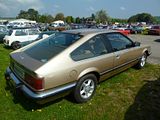 Prior to that Royale, Vauxhall’s last big car had been the PC Model Cresta and Viscount, of which this is a late model example of the latter.
Prior to that Royale, Vauxhall’s last big car had been the PC Model Cresta and Viscount, of which this is a late model example of the latter.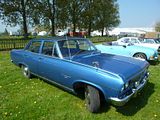 VOLKSWAGEN
VOLKSWAGENThis first generation Golf GTi followed me pretty much all the way from the outskirts of Bristol to Shepton Mallet. These cars are rare now.
 VOLVO
VOLVOA two car stand, which would be unlikely to win any prizes for imagination of execution, despite a half-hearted sort of effort that had clearly been made. The cars were nice, though, with a P1800 Coupe and the earlier PV544 model on show.

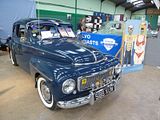 This 221 estate car was the first Volvo estate car to gain popularity in Britain and to set a theme which has lasted almost until the present day.
This 221 estate car was the first Volvo estate car to gain popularity in Britain and to set a theme which has lasted almost until the present day.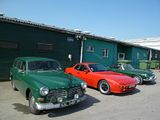 In 1975, Volvo bought out Daf, and lost little time in integrating these small cars into their range. Few survive, but here is one that does, a 66GL. Cue jokes about elastic bands, again!
In 1975, Volvo bought out Daf, and lost little time in integrating these small cars into their range. Few survive, but here is one that does, a 66GL. Cue jokes about elastic bands, again!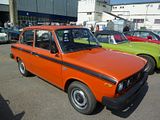
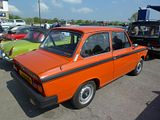
 WOLSELEY
WOLSELEYTwo of the Farina based cars featured on the stand for the owners of BMC’s mid ranged 1960s cars, one of which was a very late model 16/60. This is a car which I have seen at this event many times before, and is clearly very much pampered as it is in excellent condition.
 In 1966, Crayford were commissioned to build 57 cars based on the Wolseley Hornet to offer as prizes in a competition aimed at promoting Heinz’ 57 varieties of soup. About 25 of these cars are known still to exist, and this is one of them.
In 1966, Crayford were commissioned to build 57 cars based on the Wolseley Hornet to offer as prizes in a competition aimed at promoting Heinz’ 57 varieties of soup. About 25 of these cars are known still to exist, and this is one of them.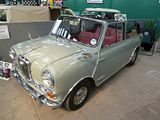


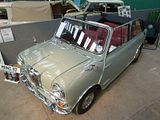 This is the 50th anniversary of the launch of the Hornet, and that fact was not ignored either, with a standard car on show inside, and a couple of other cars included in the external displays.
This is the 50th anniversary of the launch of the Hornet, and that fact was not ignored either, with a standard car on show inside, and a couple of other cars included in the external displays.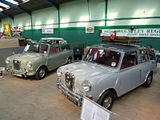 The 1500 dates from 1957 and was quite a plush car compared to its competitors at the time.
The 1500 dates from 1957 and was quite a plush car compared to its competitors at the time.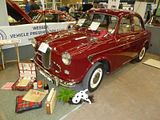
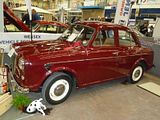 This was an excellent day out, which I thoroughly enjoyed. Moving the date to coincide with Drive It Day was an inspired move, and added greatly to the variety of cars on show. Preliminary information suggests that this will be repeated next year as the 2012 event is pencilled in for 21/22 April. Mark up your diaries accordingly.
This was an excellent day out, which I thoroughly enjoyed. Moving the date to coincide with Drive It Day was an inspired move, and added greatly to the variety of cars on show. Preliminary information suggests that this will be repeated next year as the 2012 event is pencilled in for 21/22 April. Mark up your diaries accordingly.2011-04-22 17:06:12
























































































































































































 b
b

































































































































































































